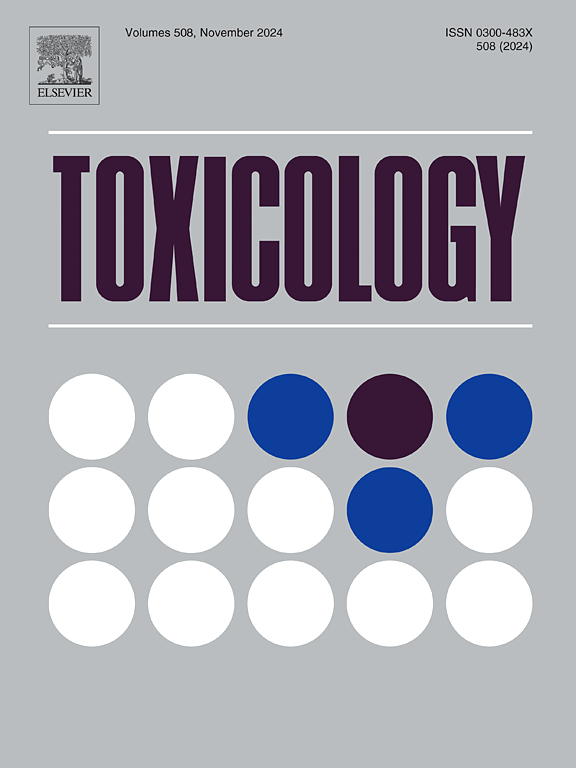Maternal, fetal, and neonatal toxicity and potency estimates of perfluorohexane sulfonate (PFHxS) from oral maternal exposure in the Sprague-Dawley rat
IF 4.6
3区 医学
Q1 PHARMACOLOGY & PHARMACY
引用次数: 0
Abstract
Perfluorohexane sulfonate (PFHxS) is a legacy, long-chain per- and polyfluoroalkyl substance (PFAS) frequently detected in human serum and environmental media across the globe. Previously published developmental studies in rats indicated a general lack of effects in common endpoints like maternal and offspring body and liver weights at doses up to 50 mg/kg/d. To facilitate mixture-based studies of PFAS co-exposure, individual dose response parameters are necessary for model predictions. To address these data needs we exposed timed-pregnant Sprague-Dawley rat dams to PFHxS (3–125 mg/kg/d) via oral gavage from gestation days (GD)14–18 or GD8 to postnatal day (PND)2. We evaluated a range of key events and adverse outcomes in both exposure intervals with a focus on chemical effects on serum thyroid hormone concentrations and liver toxicity. Maternal exposure from GD14–18 resulted in increased maternal liver weight (≥30 mg/kg), reduced serum total thyroxine (T4; ≥10 mg/kg) and low-density lipoprotein (LDL; ≥10 m/kg), and modest changes in maternal liver fatty acid metabolism-associated and fetal liver peroxisome proliferator-activated receptor signaling-associated gene expression. Exposure from GD8-PND2 did not affect newborn liver glycogen concentration, but did result in other neonatal effects consistent with prior PFAS studies including reduced pup survival (125 mg/kg), reduced pup bodyweight (≥62.5 mg/kg), increased pup liver weight (≥10 mg/kg), highly elevated pup serum total cholesterol and bile acids (≥3 mg/kg) and reduced serum thyroid hormones (T3, rT3, T4; ≥3 mg/kg). Maternal effects were largely limited to reductions in serum total T3 and T4 (≥10 mg/kg) and elevated serum BUN (≥62.5 mg/kg). Compared to previously published data for other PFAS, PFHxS displayed relatively low potency as a function of maternal serum concentration across a range of effects.
Sprague-Dawley大鼠口服全氟己烷磺酸(PFHxS)对母体、胎儿和新生儿的毒性和效力估计。
全氟己烷磺酸(PFHxS)是一种遗留的长链单氟烷基和多氟烷基物质(PFAS),经常在全球人类血清和环境介质中检测到。先前发表的大鼠发育研究表明,在高达50mg/kg/d的剂量下,对母体和后代的身体和肝脏重量等常见终点普遍缺乏影响。为了促进基于混合物的PFAS共暴露研究,个体剂量反应参数对于模型预测是必要的。为了满足这些数据需求,我们从妊娠期(GD)14-18或GD8至出生后(PND)2开始,通过灌胃的方式,将妊娠期的Sprague-Dawley大鼠暴露于PFHxS (3-125mg/kg/d)中。我们评估了两种暴露间隔的一系列关键事件和不良后果,重点是对血清甲状腺激素浓度和肝毒性的化学影响。母体暴露于GD14-18导致母体肝脏重量增加(≥30mg/kg),血清总甲状腺素(T4;≥10mg/kg)和低密度脂蛋白(LDL;≥10m/kg),母体肝脏脂肪酸代谢相关和胎儿肝脏过氧化物酶体增殖物激活受体信号相关基因表达的适度变化。GD8-PND2暴露不影响新生儿肝糖原浓度,但确实导致了与先前PFAS研究一致的其他新生儿效应,包括幼犬存活率降低(125mg/kg),幼犬体重降低(≥62.5mg/kg),幼犬肝脏重量增加(≥10mg/kg),幼犬血清总胆固醇和胆胆酸高升高(≥3mg/kg),血清甲状腺激素(T3, rT3, T4;≥3毫克/公斤)。母体效应主要局限于血清总T3和T4降低(≥10mg/kg)和血清BUN升高(≥62.5mg/kg)。与先前发表的其他PFAS数据相比,PFHxS在一系列影响中表现出相对较低的效力,作为母体血清浓度的函数。
本文章由计算机程序翻译,如有差异,请以英文原文为准。
求助全文
约1分钟内获得全文
求助全文
来源期刊

Toxicology
医学-毒理学
CiteScore
7.80
自引率
4.40%
发文量
222
审稿时长
23 days
期刊介绍:
Toxicology is an international, peer-reviewed journal that publishes only the highest quality original scientific research and critical reviews describing hypothesis-based investigations into mechanisms of toxicity associated with exposures to xenobiotic chemicals, particularly as it relates to human health. In this respect "mechanisms" is defined on both the macro (e.g. physiological, biological, kinetic, species, sex, etc.) and molecular (genomic, transcriptomic, metabolic, etc.) scale. Emphasis is placed on findings that identify novel hazards and that can be extrapolated to exposures and mechanisms that are relevant to estimating human risk. Toxicology also publishes brief communications, personal commentaries and opinion articles, as well as concise expert reviews on contemporary topics. All research and review articles published in Toxicology are subject to rigorous peer review. Authors are asked to contact the Editor-in-Chief prior to submitting review articles or commentaries for consideration for publication in Toxicology.
 求助内容:
求助内容: 应助结果提醒方式:
应助结果提醒方式:


